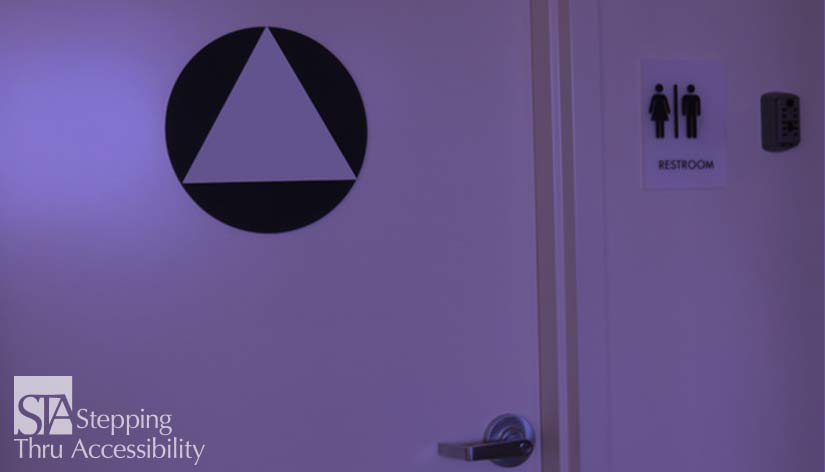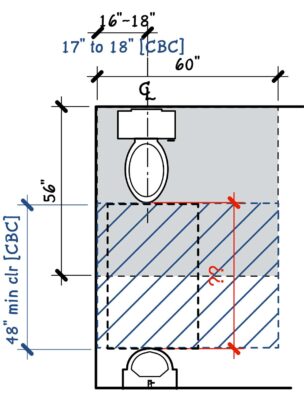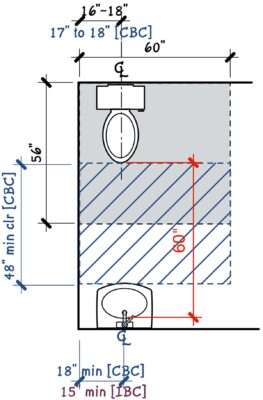Blog
Return to Blog »
Janis Kent, FAIA Architect, CASp © September, 2024 One of the items about Access that is challenging is putting together different portions of the codes and regulations. We probably know the requirements for separate elements but what gets triggered when you start putting them together in different layouts? Recently I came across an item in a single user toilet room. The urinal was placed directly across from the toilet which started me on this train of thought. So the question is – how much space do you really need between the 2 fixtures – the urinal and the toilet? And of course, the answer, is it depends. Under the ADA, a toilet in a single user toilet room requires 56″ deep from the plumbing wall by 60″ minimum in width. CBC requires an additional 48″ clear space measured from the front of the toilet by 60″ in width. These clearances for a toilet allow people to transfer from their wheelchair using different methods, whether a diagonal or side transfer. Now let’s look at the urinal placed on the wall opposite the toilet. The urinal requires a 30″ x 48″ clear floor space for a forward approach. So, if you leave 48″ between the front face of the urinal to the front face of the toilet, would that be enough space? And would that allow for a forward approach? The answer is no, since the short open end is touching the front of the toilet, and basically the toilet and urinal fixtures confine the clear floor space on 3 sides. But how much space do you actually need? Let’s look at this in terms of maneuvering clearances. If you had a forward approach of 30″ x 48″, you would enter on the short side, which in this example is blocked by the toilet. So one needs to maneuver in order to get the required forward approach to the urinal. Below are the required clearances if confined on all or part of 3 sides. Since the toilet is centered 16″ to 18″ (ADA) from the wall [or 17″ to 18″ for CBC], and if the urinal is placed opposite the toilet, the clear floor space is effectively confined on all or part of 3 sides. The urinal clear floor space does not need to be centered on the fixture, but if the fixture is 15″ wide and placed a few inches from the wall adjacent, you have now effectively confined both short ends of its clear floor space for more than a 15″ depth. So consider a parallel approach in an alcove. If the two short sides are blocked more than 15″, which in this case it is, the 48″ length of the clear floor space is extended to 60″ in order to maneuver for a forward approach. Hence, you will now need a 60″ clear floor space in front of the urinal to the toilet. If the urinal has toe clearance below of 6″ deep by 9″ minimum in height, then the 60″ deep maneuvering space can go underneath the urinal 6″. So from the face of a urinal to a toilet, you would need 54″ clear. Now with this same thinking process, if you placed a lavatory across from the toilet you would also be required to provide a forward approach, but since a lavatory requires 17″ minimum knee/toe clearance below, the clearance from the face of the lavatory to the toilet would go down to 43″ minimum. But note, if this is in California, you would still have to provide the 48″ clear depth, since that is a CBC requirement of the toilet clearances. So what was originally a 48″ long 2-dimensional rectangle placed on plans in front of a urinal, as required for its clear floor space, when thinking of actually maneuvering for a forward approach, that dimension needs to increase to provide 60″. Then one can look at using the toe clearance below if provided at the urinal. And for the lavatory, knee/toe clearance is always required below so less space is required beyond for a forward approach. One has to synthesize the requirements not just for the object itself, but also to visualize 3-dimensionally how to maneuver and access the element. The requirements are there – you just have to put it together. So do not just assume, and do not plunk down rectangles on a drawing and think you are all set. Be aware that your local City or County may have additional requirements that are more restrictive than the State or Federal requirements. Also, this article is an interpretation and opinion of the writer. It is meant as a summary – current original regulations should always be reviewed when making any decisions. © Janis Kent, Architect, FAIA, CASp September, 2024Toilet Room Clear Floor Spaces – How do they get synthesized?



